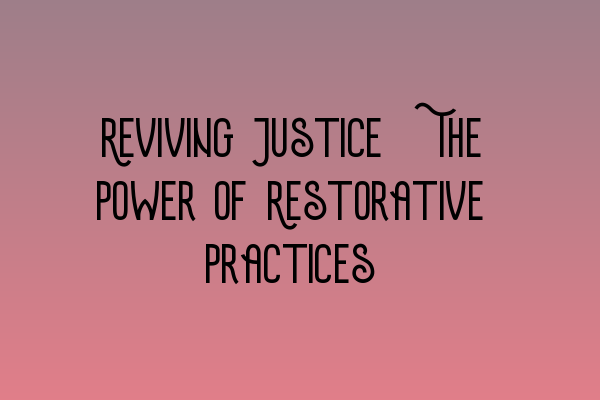Reviving Justice: The Power of Restorative Practices
As the legal landscape continues to evolve, there is an increasing recognition of the limitations of traditional punitive measures in achieving true justice. The criminal justice system, with its focus on punishment and retribution, often fails to address the underlying causes of crime and provide meaningful resolutions for victims, offenders, and the community at large.
However, there is a growing movement towards embracing restorative practices as a powerful alternative to traditional approaches. Restorative justice puts an emphasis on healing and repairing the harm caused by criminal behavior through meaningful dialogue, accountability, and rehabilitation. This shift in approach has the potential to transform the way we view and deliver justice in the UK.
The Essence of Restorative Justice
Restorative justice is grounded in the fundamental principles of inclusion, fairness, and empowerment. It recognizes that crime is not just a violation of the law, but also a breach of relationships and a disruption of community harmony. At its core, restorative justice seeks to restore these relationships and enable all affected parties to participate actively in finding resolution.
Unlike traditional criminal justice processes, restorative practices prioritize the needs and perspectives of victims, giving them a voice and empowering them in the decision-making process. Offenders are held accountable for their actions, but they are also given the opportunity to understand the consequences of their behavior and make amends to those they have harmed.
The Benefits of Restorative Practices
Restorative practices offer a number of significant benefits that surpass the limitations of punitive measures. By focusing on healing and repairing harm, restorative justice provides a more holistic and comprehensive approach to addressing the consequences of crime.
For victims, restorative practices offer the opportunity to be actively involved in the resolution process, allowing them to express their feelings, ask questions, and receive answers directly from the offender. This can bring a sense of closure and empowerment, helping victims to heal and move forward.
Similarly, restorative practices offer offenders the chance to take responsibility for their actions and gain a deeper understanding of the impact they have had on others. Through face-to-face dialogues and mediated discussions, offenders can develop empathy, learn from their mistakes, and make meaningful amends.
For communities, restorative justice initiatives foster a sense of collective responsibility and encourage community members to actively participate in the resolution process. By involving the community, restorative practices promote healing, reconciliation, and a renewed sense of trust and safety.
Implementing Restorative Practices
While the concept of restorative justice may seem idealistic, its implementation is more realistic than one might think. In recent years, numerous pilot projects and initiatives have demonstrated the effectiveness of restorative practices in various contexts.
For example, in cases of minor offenses, such as theft or vandalism, restorative justice conferencing has proven successful in diverting offenders away from the criminal justice system. Through facilitated discussions, victims and offenders are able to communicate openly, find mutual understanding, and work together to develop a plan to repair the harm done.
Restorative justice practices have also been successfully employed in cases of more serious offenses, such as assault or even murder. In these instances, restorative justice processes can provide an opportunity for victims to confront their offenders, seek answers to difficult questions, and find a path towards healing and forgiveness.
As the benefits of restorative practices become increasingly apparent, it is essential for legal professionals, policymakers, and the general public to embrace and support this transformative approach to justice. By investing in research and training, as well as fostering collaboration between various stakeholders, we can create a criminal justice system that prioritizes healing, accountability, and community engagement.
In conclusion, restorative practices hold immense potential in revitalizing the concept of justice. By shifting our focus towards healing and repairing harm, we can create a more compassionate and effective criminal justice system that truly serves the needs of victims, offenders, and the wider community.
Related Articles:
